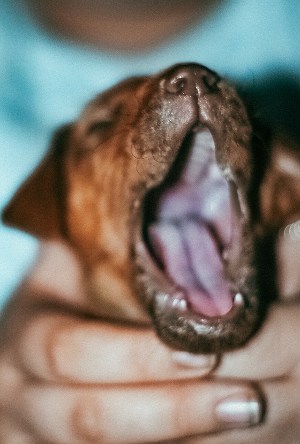
Humans have uvulas, and we always see them in cartoons when the characters scream, yawn, or cry. What am I talking about?
It’s that dangly little thing at the back of your throat that kind of looks like an upside-down heart.
You know, the thing you see when someone yawns way too hard without covering their mouth. How rude!
But, what even is a uvula?
And what is it used for?
More importantly, do dogs have them, and what could go wrong with them?
What else could go wrong in their throats, and what should you do about it?
Let’s find out.
[1] What is a uvula?
A uvula is the soft flap of tissue hanging down at the roof of your mouth, all the way at the back. You know, the one you always see when cartoon characters scream really loudly. Also, if you touch it (why would you do that??), you’re likely to gag and possibly throw up. Just saying.
[2] Do dogs have a uvula?
We see them in cartoons, and we assume that everyone has one. But dogs don’t have them. In fact, except for some primates, only humans have uvulas. Neat!
[3] What function or role does it play?
The uvula is quite a fascinating little organ, unique to humans. According to science, the uvula lubricates the vocal chord. That’s pretty cool since the uvula can produce a ton of saliva at the drop of a hat. Like, seriously. The uvula is closely linked to speech and seems to be one of the biological markers that differentiate humans from other mammals.
Then, there’s the gag reflex. The uvula plays a vital role in helping your body gag when something tries to get in through your mouth uninvited. When anything touches the back of your throat – basically, if it touches your uvula – your throat muscles constrict, causing you to gag or even vomit.
The uvula also helps your food and drink go down the right way, keeping it away from your lungs and nose. It’s a pretty neat little organ and incredibly useful.
[4] Can dogs exist without them?
They sure can! Dogs don’t have uvulas, so they’ve been happily living without them since time immemorial. Unless we’ve been captured by aliens, and they’re manipulating our perception of reality. In which case, dogs might not even exist. Or you might not exist. Or this entire world is a figment of your imagination! Okay, okay, calm down already.
[5] What are common problems that dogs have with uvulas?
Since dogs don’t have uvulas, they can’t have problems with it. Unless they get offended at seeing yours. You know, when you yawn, those big I-should-have-gone-to-bed-hours-ago-but-instead-binged-an-entire-series yawns without covering your mouth. That’s on you, I’m afraid.
[6] Are uvulas the same as tonsils?
No, they’re not. You can find tonsils on either side at the back of your throat. These bad boys are made of lymph tissue and help make antibodies that protect you from disease. Additionally, your body uses them, kind of like a filter, to catch bacteria and dust that try to infiltrate your body. Sometimes, tonsils act up, catching too many bugs and getting infected. In this case, they end up making you ill instead of keeping your body in pristine condition. That’s when you get them removed, usually as a kid. The same goes for adenoids, which are the same as tonsils but located higher up in the throat, closer to your nose.
The uvula, made of soft tissue, hangs from the roof of your mouth. You know, all the way at the back where your mouth and throat get together. It doesn’t play any role in fighting disease and very rarely causes any form of trouble. So no, tonsils and uvulas are very much not the same.
[7] What are the other main “organs” in a dog’s throat apart from the tongue and teeth?
Here’s something cool: your dog’s throat looks much the same as yours. He has four major organs: larynx, trachea, esophagus, and epiglottis. What on earth are these, right? The larynx is the area that connects the nose and trachea. This area does many different things, but mainly it serves as protection for the lower airways and houses the voice box. It comprises cartilage, soft tissue, and ligaments and contains secretory membranes, like tonsils and adenoids.
The trachea is a fancy word for the windpipe. Then, there’s the epiglottis. This remarkable organ is a piece of cartilage at the back of the tongue. It acts as a flap, closing the windpipe’s opening and opening the way to the esophagus when your pup swallows. The esophagus is the tube that goes down to Rover’s stomach.
[8] What are the main problems that dogs might have with their throats?
The most common problem that dogs experience in their throats is pharyngitis. Here, the esophagus’s lining (called the pharynx) becomes swollen or inflamed, causing severe pain and sometimes completely constricting the throat. This condition has many possible causes and ranges in severity. If Rover swallowed a sharp bone, it could have damaged the pharynx, causing infection. He could have a bacterial infection that attacked the pharynx. In severe cases, he might even have cancer in the pharynx.
None of these are good, and since his throat is sore, he might not whine or bark to let you know. You know, since that would hurt as well. Poor pup. Usually, the first sign of pharyngitis is coughing. Dogs shouldn’t cough, ever, if they’re healthy. So, if your pup coughs, it’s a good idea to have him checked out by the vet.
[9] Do dogs have a gag reflex?
Yes, they do! And that’s a good thing since dogs are notorious for eating things that they shouldn’t. This well-developed gag reflex is the reason that perfectly healthy dogs vomit easily and often. So, usually, it’s nothing to worry about, although it could be a sign that something more sinister is afoot. When you notice your pup vomiting, check (gross, I know!) his vomit for clues. If you notice string, holiday tinsel, fishing line or hooks, anything sharp, cloth, plastic, glass, metal, toys, pills, poison, blood, or basically anything that shouldn’t have entered his mouth in the first place, take him to the vet immediately. He might have swallowed something that could cause serious harm, and it’s essential to get help before things get worse.
[10] What other pets have a uvula?
Humans and two types of baboons are the only ones that have uvulas. So, unless you have an exotic pet license and added some baboons to your family, your pet probably doesn’t have a uvula. I know the cartoons misled all of us, and it’s a little bit sad, but we’ll all get over it, I’m sure.
Closing Thoughts
Fully formed uvulas are unique to humans and have an extensive range of functions. This distinguishing organ assists in speech, directs food along the correct channels and triggers the gag reflex. But, just because dogs don’t have them doesn’t mean that they don’t have a gag reflex. Dogs actually have a very sensitive gag reflex, which is fantastic since they constantly shove all sorts of things down their throats.
Dogs have other things in their throats, though. Just like humans, they have tonsils and adenoids that help protect them from disease. Yup, your fur kid could even develop tonsillitis, just like you. We have so much more in common than we realize, right?





